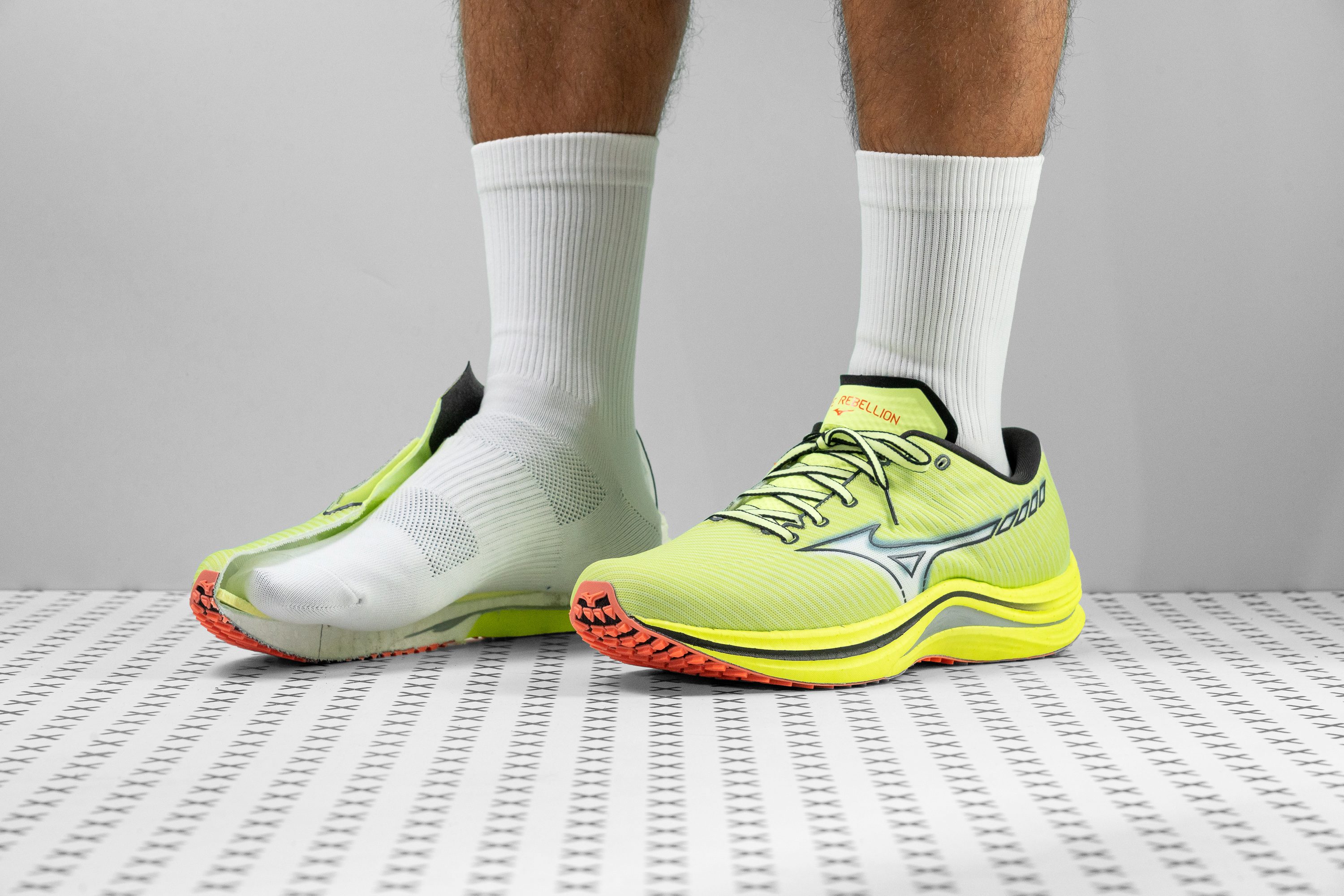Our verdict
Pros
- Unique geometry
- Exceptionally lightweight
- Responsive midsole
- Versatile for both tempo pace and long runs
- Superior heel lock
- Remarkable stability
- Spacious toebox
Cons
- Potentially overpriced at $180
- Lacks outsole durability
- Thin oversized tongue
Audience verdict
Comparison
The most similar running shoes compared
+ + Add a shoe | |||||
|---|---|---|---|---|---|
| Audience score | 87 Great! | 89 Great! | 93 Superb! | 90 Superb! | |
| Price | £180 | £220 | £130 | £150 | |
| Pace | Tempo | Daily runningTempo | Daily runningTempo | Daily runningTempo | |
| Shock absorption | - | High | High | Moderate | |
| Energy return | - | Low | High | Moderate | |
| Traction | - | Moderate | Moderate | Moderate | |
| Arch support | Neutral | Neutral | Neutral | Neutral | |
| Weight lab Weight brand | 8.7 oz / 247g 9.1 oz / 259g | 9.1 oz / 258g 9 oz / 255g | 7.9 oz / 223g 7.9 oz / 224g | 8.6 oz / 245g 9.2 oz / 260g | |
| Lightweight | ✓ | ✗ | ✓ | ✓ | |
| Drop lab Drop brand | 7.7 mm 8.0 mm | 6.7 mm 6.0 mm | 8.0 mm 6.5 mm | 7.9 mm 8.0 mm | |
| Strike pattern | Mid/forefoot | Mid/forefoot | HeelMid/forefoot | Mid/forefoot | |
| Size | Slightly large | True to size | True to size | True to size | |
| Midsole softness | Balanced | Soft | Balanced | Balanced | |
| Difference in midsole softness in cold | Normal | Small | Small | Small | |
| Toebox durability | Decent | Decent | Bad | Decent | |
| Heel padding durability | Decent | Bad | Good | Decent | |
| Outsole durability | Bad | Good | Good | Good | |
| Breathability | Moderate | Moderate | Breathable | Moderate | |
| Width / fit | Medium | Medium | Medium | Medium | |
| Toebox width | Medium | Medium | Medium | Medium | |
| Stiffness | Stiff | Moderate | Flexible | Moderate | |
| Torsional rigidity | Stiff | Stiff | Stiff | Stiff | |
| Heel counter stiffness | Stiff | Moderate | Moderate | Flexible | |
| Rocker | ✓ | ✗ | ✓ | ✗ | |
| Heel lab Heel brand | 36.4 mm 36.0 mm | 39.7 mm 37.0 mm | 36.1 mm 38.5 mm | 36.1 mm 31.0 mm | |
| Forefoot lab Forefoot brand | 28.7 mm 28.0 mm | 33.0 mm 31.0 mm | 28.1 mm 32.0 mm | 28.2 mm 23.0 mm | |
| Widths available | Normal | Normal | NormalWide | Normal | |
| Orthotic friendly | ✓ | ✓ | ✓ | ✓ | |
| Season | All seasons | All seasons | SummerAll seasons | All seasons | |
| Removable insole | ✓ | ✓ | ✓ | ✓ | |
| Ranking | #165 Top 44% | #95 Top 26% | #3 Top 1% | #64 Top 18% | |
| Popularity | #277 Bottom 26% | #174 Top 47% | #15 Top 4% | #123 Top 33% |
Who should buy
While this is an interesting shoe, it may not suit everyone. We recommend it for:
- Runners looking for a versatile shoe capable of handling both easy and tempo training sessions, even on the track.
- Those seeking a running shoe that offers ample cushioning for extended runs, all packaged in a lightweight design.
- Mizuno aficionados who wish to broaden their rotation with a shoe that can do it all in the roads and dirt paths.
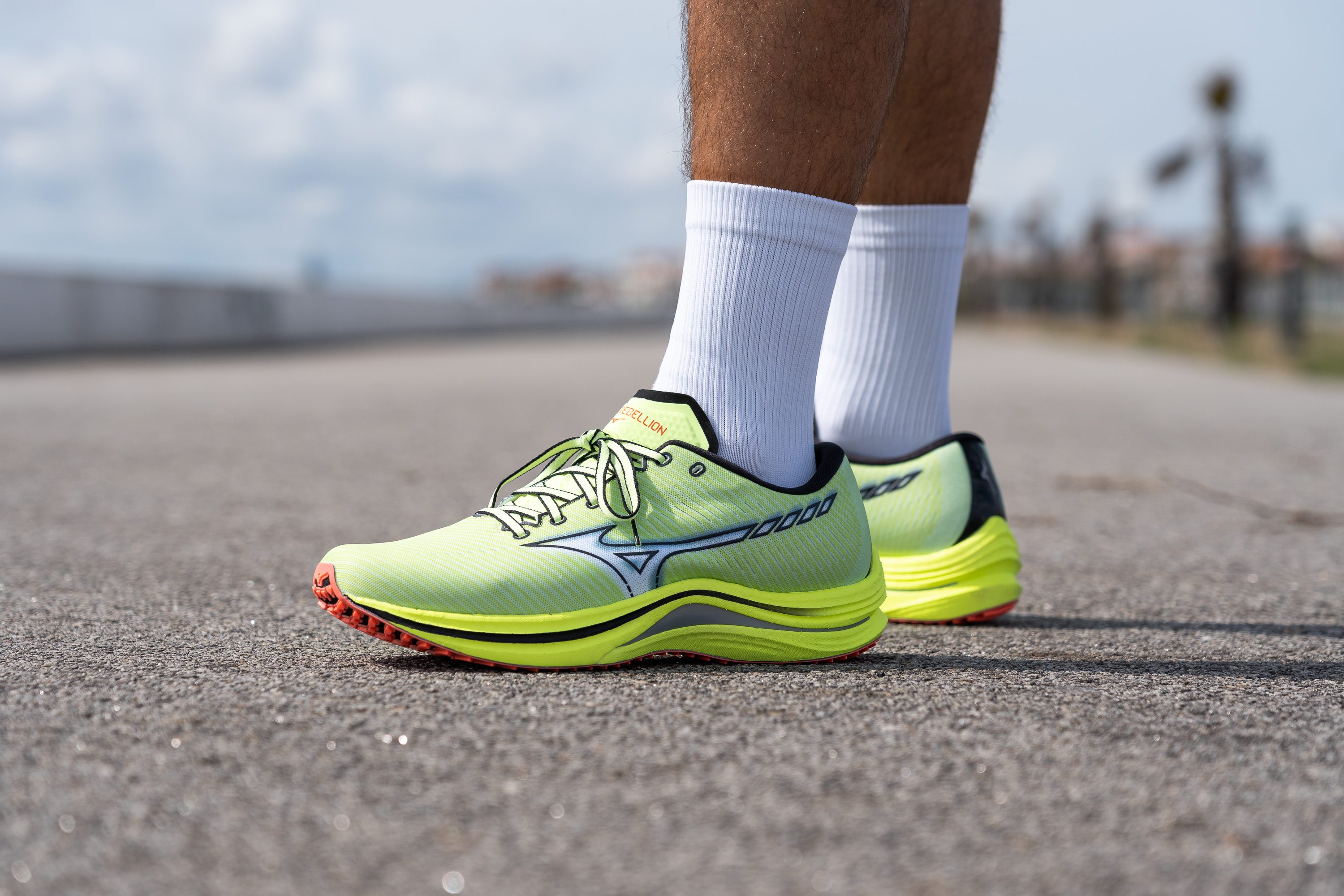
Who should NOT buy
If you're a runner who tends to wear out the outsoles on most running shoes quickly, we advise steering clear of this Mizuno. You might want to consider a comparable running shoe with a more robust outsole, such as the Puma Deviate Nitro 2.
This shoe may also be a poor fit for runners with narrow feet since it runs wide. If you're looking for narrower shoes that can also serve as reliable tempo training partners for long runs, consider options like the Saucony Endorphin Speed 3 or the Hoka Mach 5.

Cushioning
Heel stack
Boasting 36.4 mm of foam in the heel, this lightweight running shoe is capable of any long run even for heel strikers. The superior cushioning that we felt underfoot was truly impressive, and the lab-based measurement provided just the validation we needed.
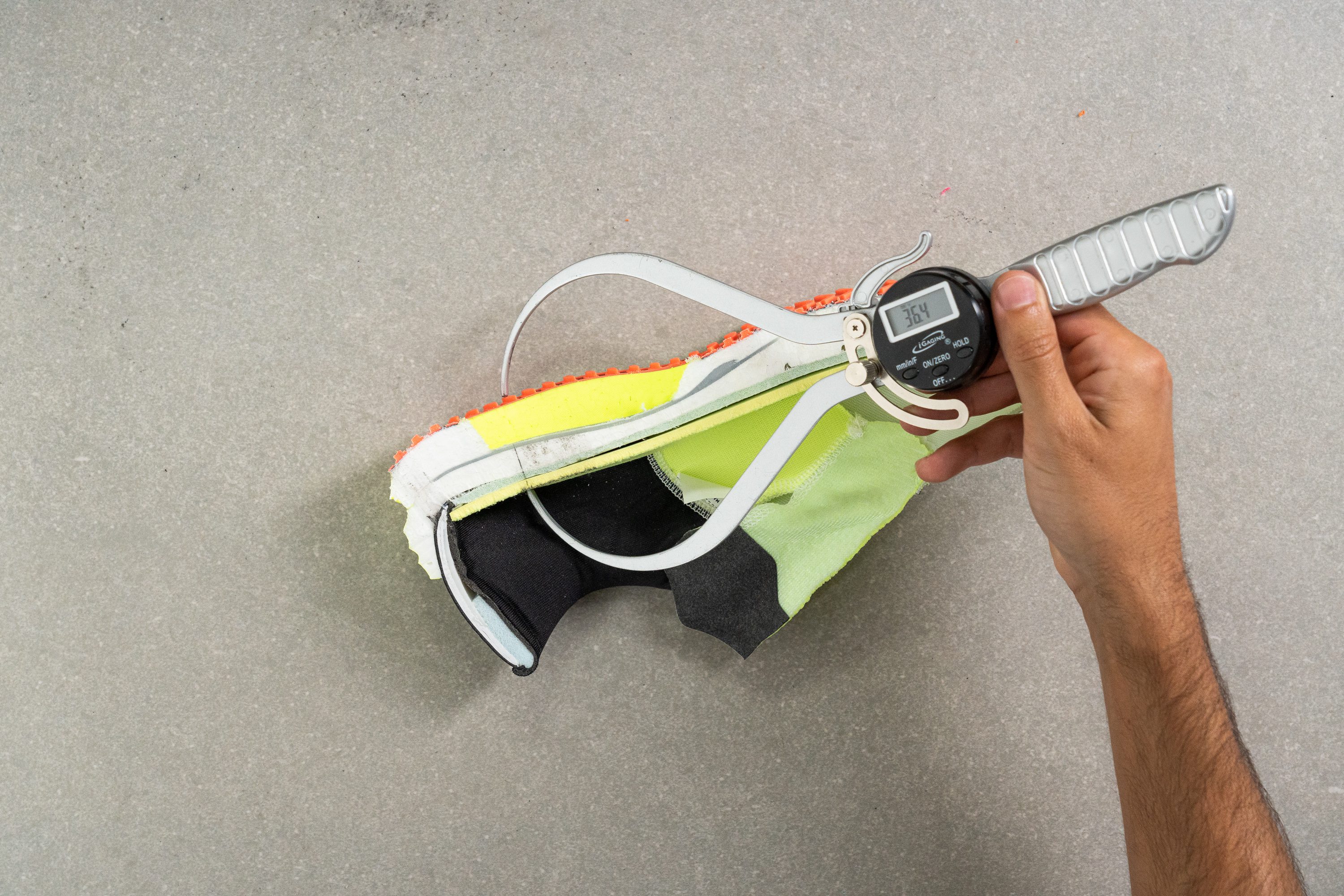
| Wave Rebellion | 36.4 mm |
| Average | 34.8 mm |
Forefoot stack
We found a substantial 28.7 mm of foam in the forefoot area during our measurements.

This is indeed enough to endure any workout, and it's plenty to satisfy the needs of forefoot strikers.

| Wave Rebellion | 28.7 mm |
| Average | 26.2 mm |
Drop
Kudos to Mizuno on this one! Lately we're seeing some pretty wild differences between a brand's stated drop and our meticulous measurements.
This time we clocked a 7.7 mm with the calliper when Mizuno claimed 8 mm. Now, that's some cool Japanese precision!

| Wave Rebellion | 7.7 mm |
| Average | 8.6 mm |
Midsole softness
Living up to its reputation, Mizuno delivers another moderately firm midsole with this shoe.
Registering at 24.3 HA, the Enerzy Lite foam offers a springy ride. However, don't expect an ultra-soft feel under your foot. It provides more of a classic running experience.

| Wave Rebellion | 24.3 HA |
| Average | 20.4 HA |
Size and fit
Size
Mizuno Wave Rebellion fits slightly large (20 votes).
Toebox width - widest part
Mizuno has a clear affinity for crafting shoes suitable for wide feet, and this model proves it once again.
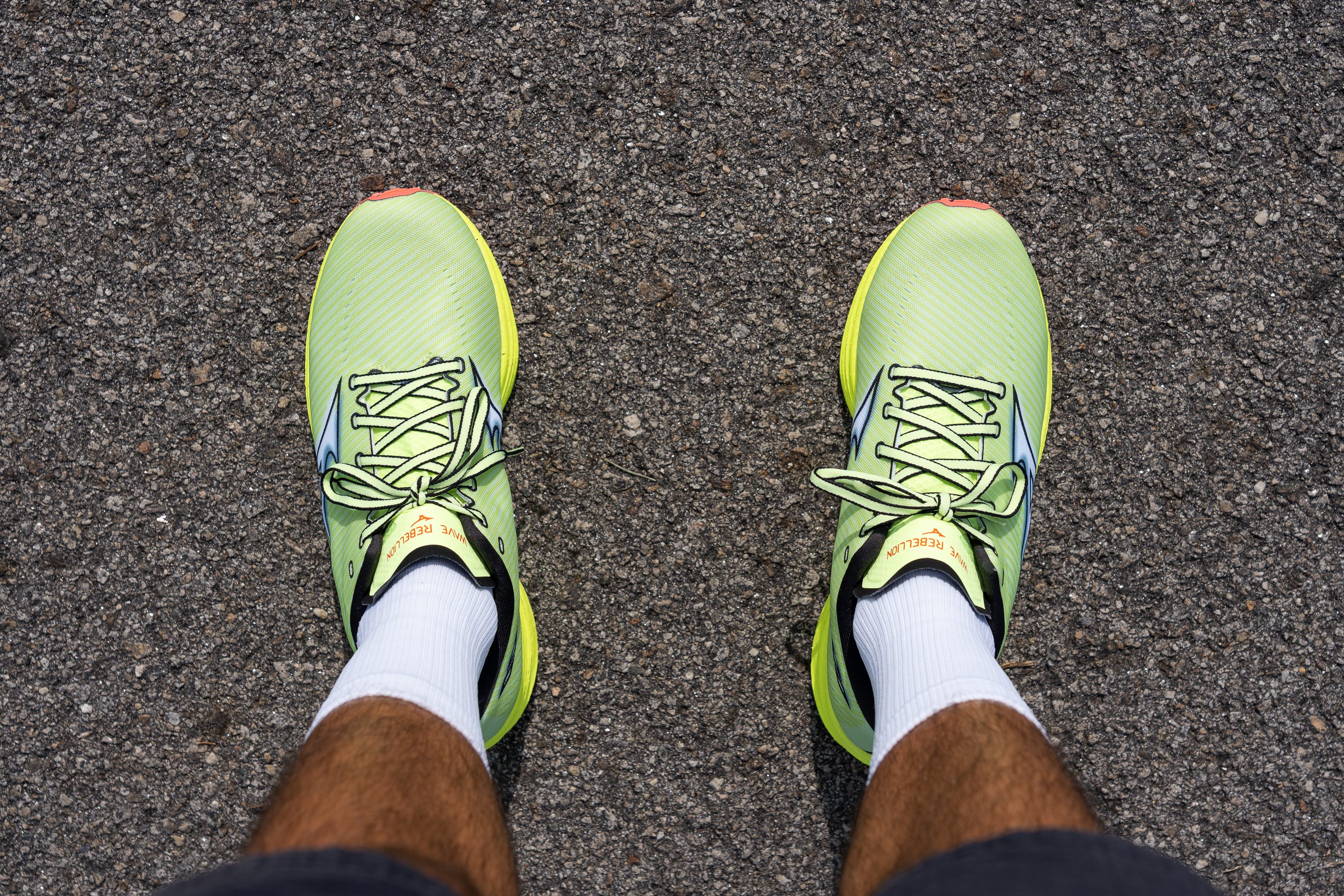
With a roomy measurement of 101.7 mm, the upper comfortably accommodates nearly all foot types, eliminating any need for a wider size. However, if you have narrow feet, you might want to consider another shoe like the Nike ZoomX Streakfly.
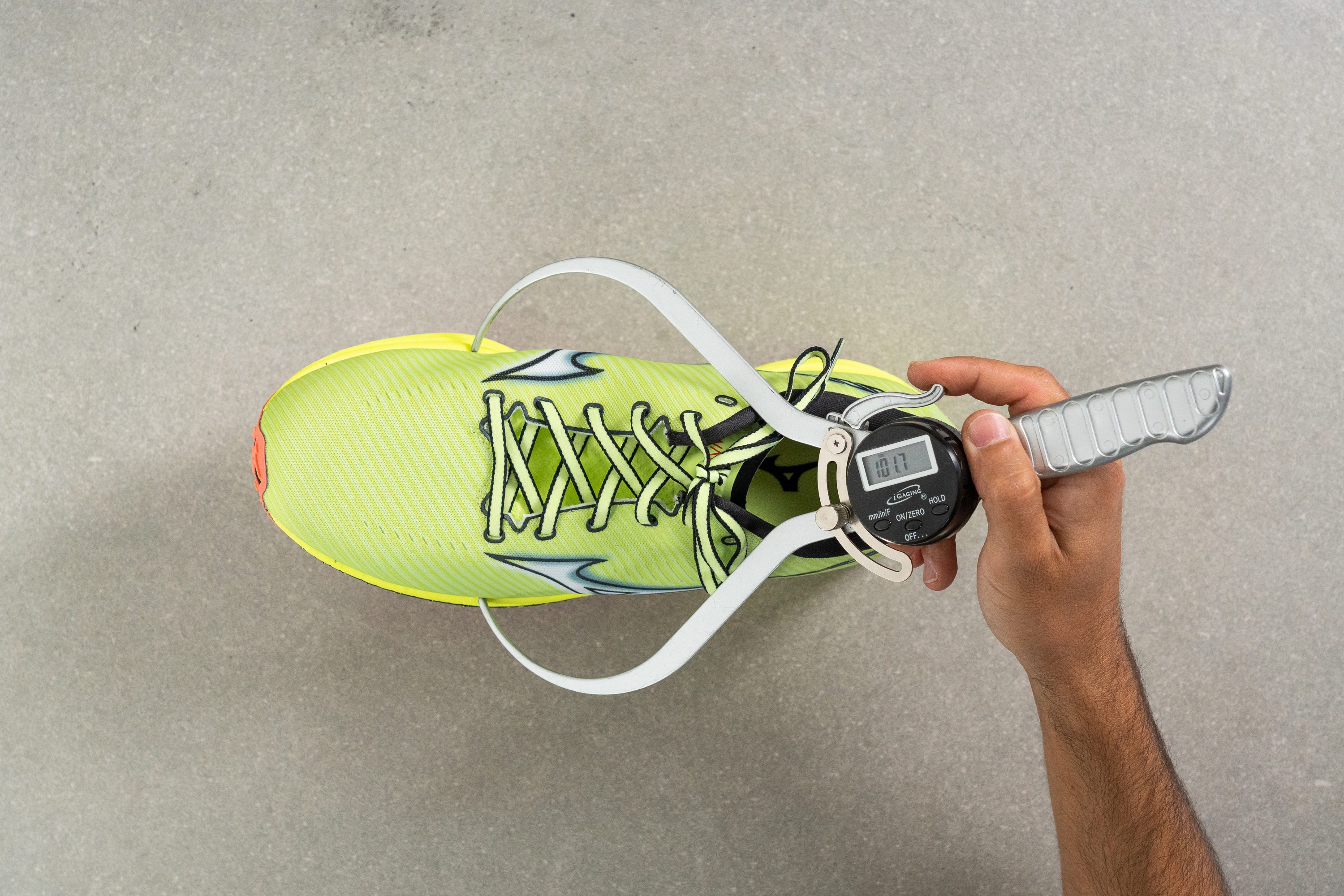
This test follows an older methodology, which is why you don't see recently tested shoes in the chart. Results from different methodologies can not be compared.
| Wave Rebellion | 101.7 mm |
| Average | 98.5 mm |
Toebox width - big toe
The shoe's roominess isn't limited to its widest part—it extends to the toe area as well. Our precise measurements clock the toe region at a generous 79 mm.
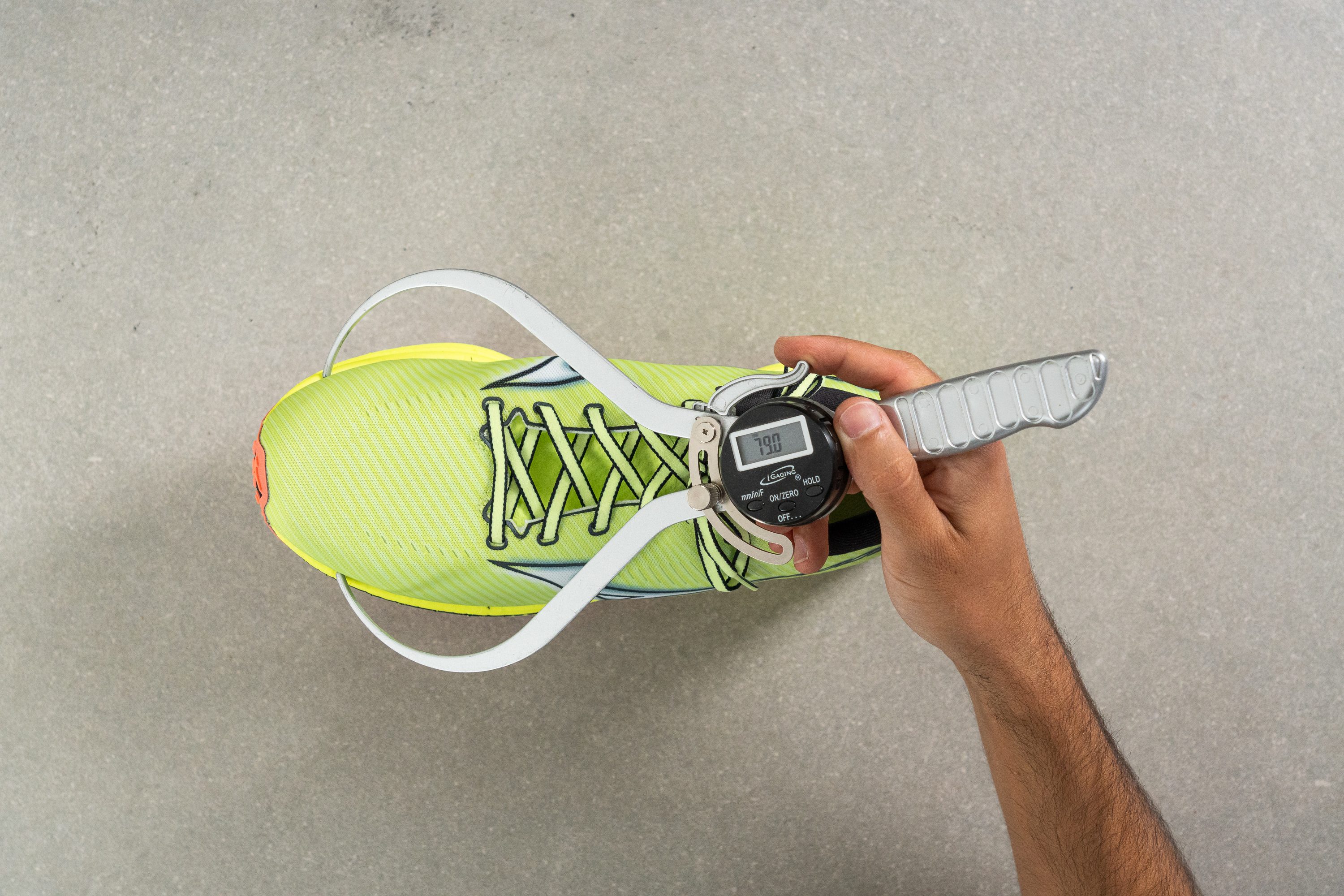
This test follows an older methodology, which is why you don't see recently tested shoes in the chart. Results from different methodologies can not be compared.
| Wave Rebellion | 79.0 mm |
| Average | 78.4 mm |
Flexibility / Stiffness
Some runners assume that shoes with a plate will always be super stiff, but that's just not true. Shoes with Pebax or fibreglass plates, like the Wave Rebellion, stay pretty flexible, unlike those with carbon-fibre plates.
To prove it, we only had to apply 26.1N of force to bend it 90 degrees. That's less than most running shoes ask of us!
This test follows an older methodology, which is why you don't see recently tested shoes in the chart. Results from different methodologies can not be compared.
| Wave Rebellion | 26.1N |
| Average | 28.1N |
Stiffness in cold (%)
In cold temperatures, the shoe does get a tad stiffer—we needed to apply 32.3N of force to bend it 90 degrees.
But here's the thing. Most of the shoe's stiffness stems from the fibreglass plate, which isn't affected by cold. So, the actual difference ends up being minor.
In reality, it's just a 23.7% increase. A truly outstanding performance!
| Wave Rebellion | 24% |
| Average | 33% |
Weight
Tipping the scales at a featherlight 8.7 oz (247g), we certainly classify this as a delightfully light shoe.
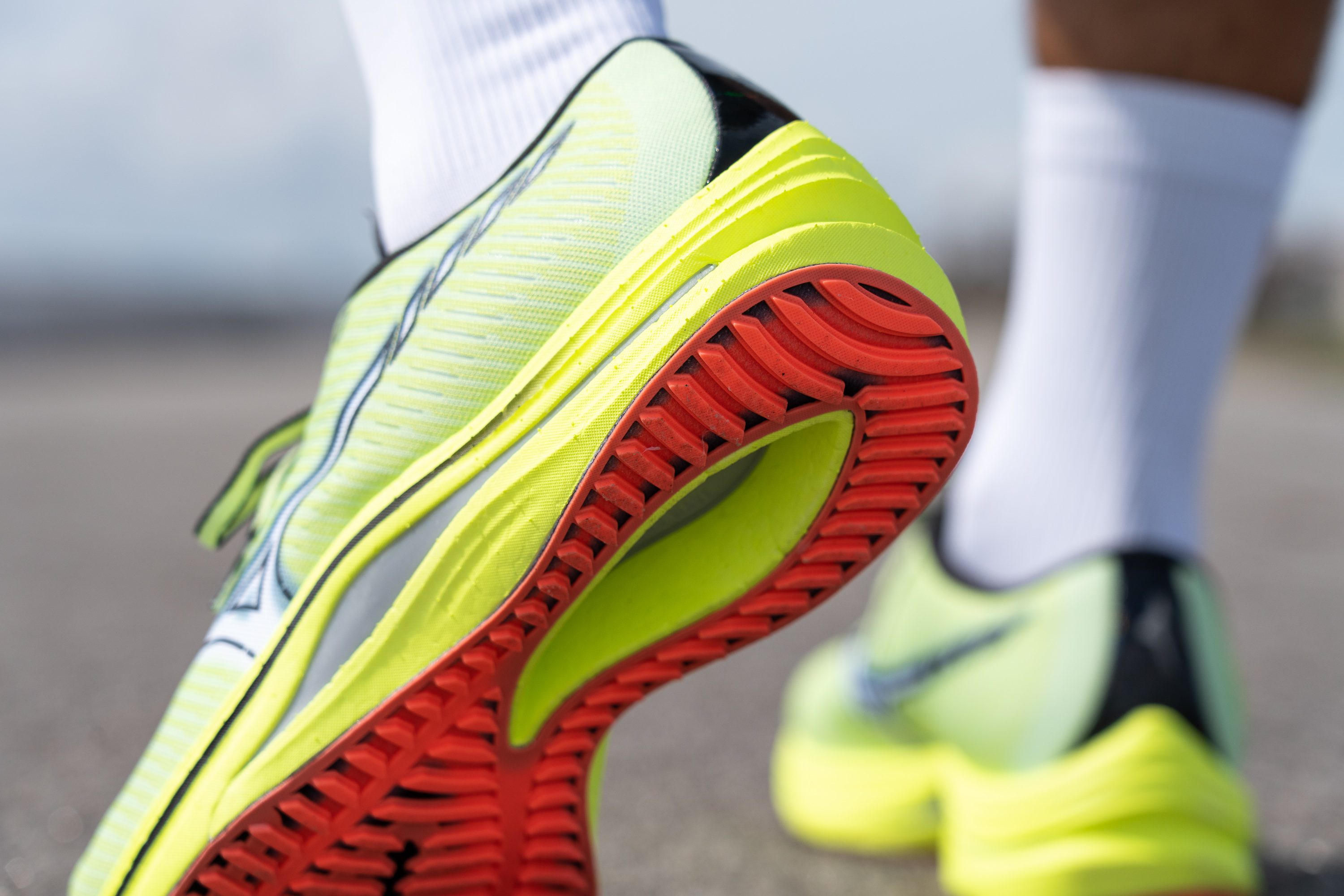
Of course, the ingenious cutout in the heel we've previously mentioned deserves abundant credit for this weight reduction.
| Wave Rebellion | 8.7 oz (247g) |
| Average | 9.3 oz (264g) |
Breathability
In the past decade, breathable shoes were hard to find, but that's not the case anymore. That's why we felt a tad let down when, after our smoke-pumping test in the lab, the Wave Rebellion only scored a 3/5. This result seems low for a shoe that costs £180.
But we do have some good news. We discovered breathable sections on the medial side of the shoe when we put it under the light. This feature isn't always present in all shoes, and we truly value it. It's beneficial for runners who tend to get blisters on their arches.
Nevertheless, nothing helps understand this shoe's subpar breathability better than a microscope. The Wave Rebellion is constructed from a thin but dense engineered mesh, and it doesn't feature any ventilation holes.
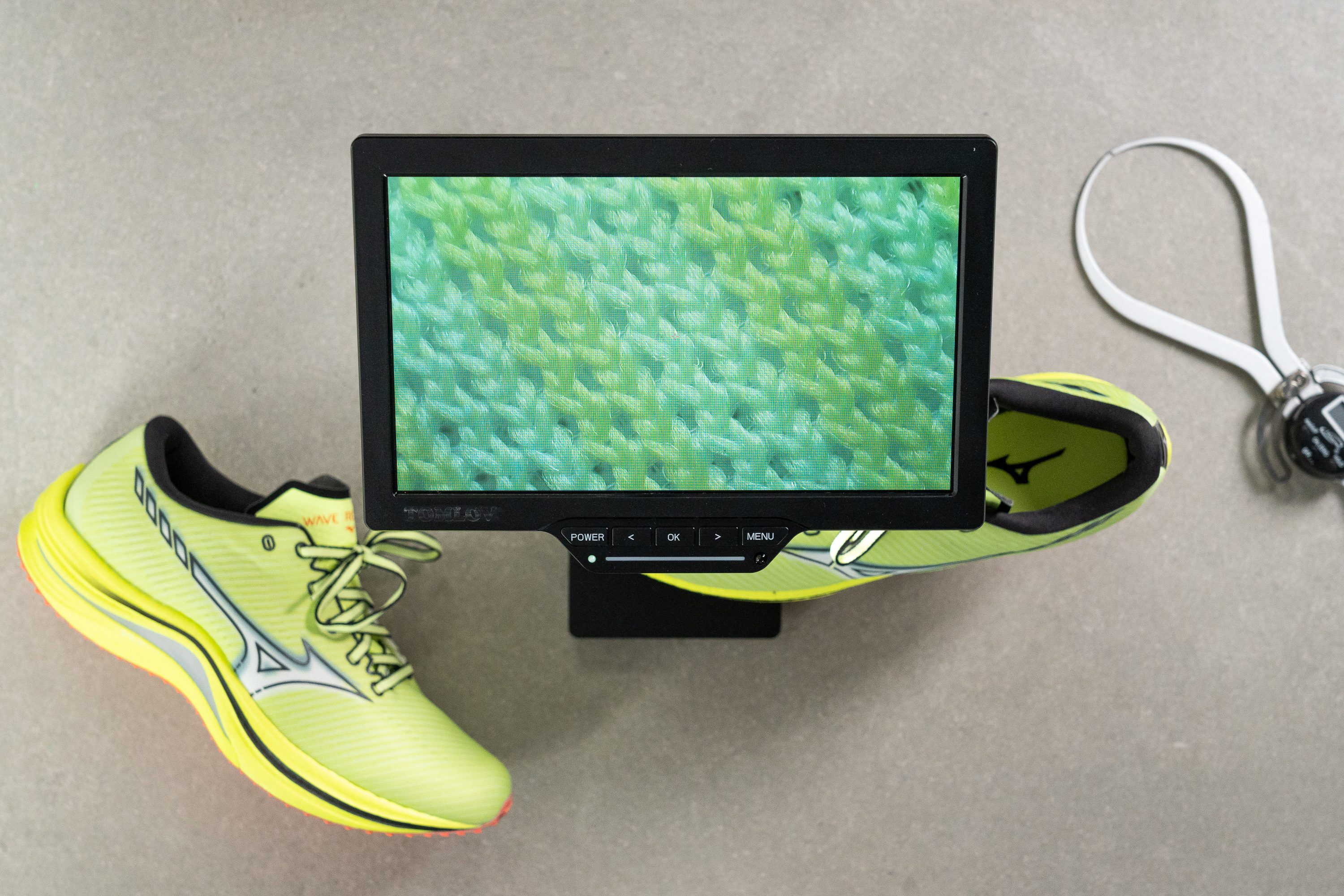
Mizuno believed a thin mesh would suffice, but it's clear that isn't the case.
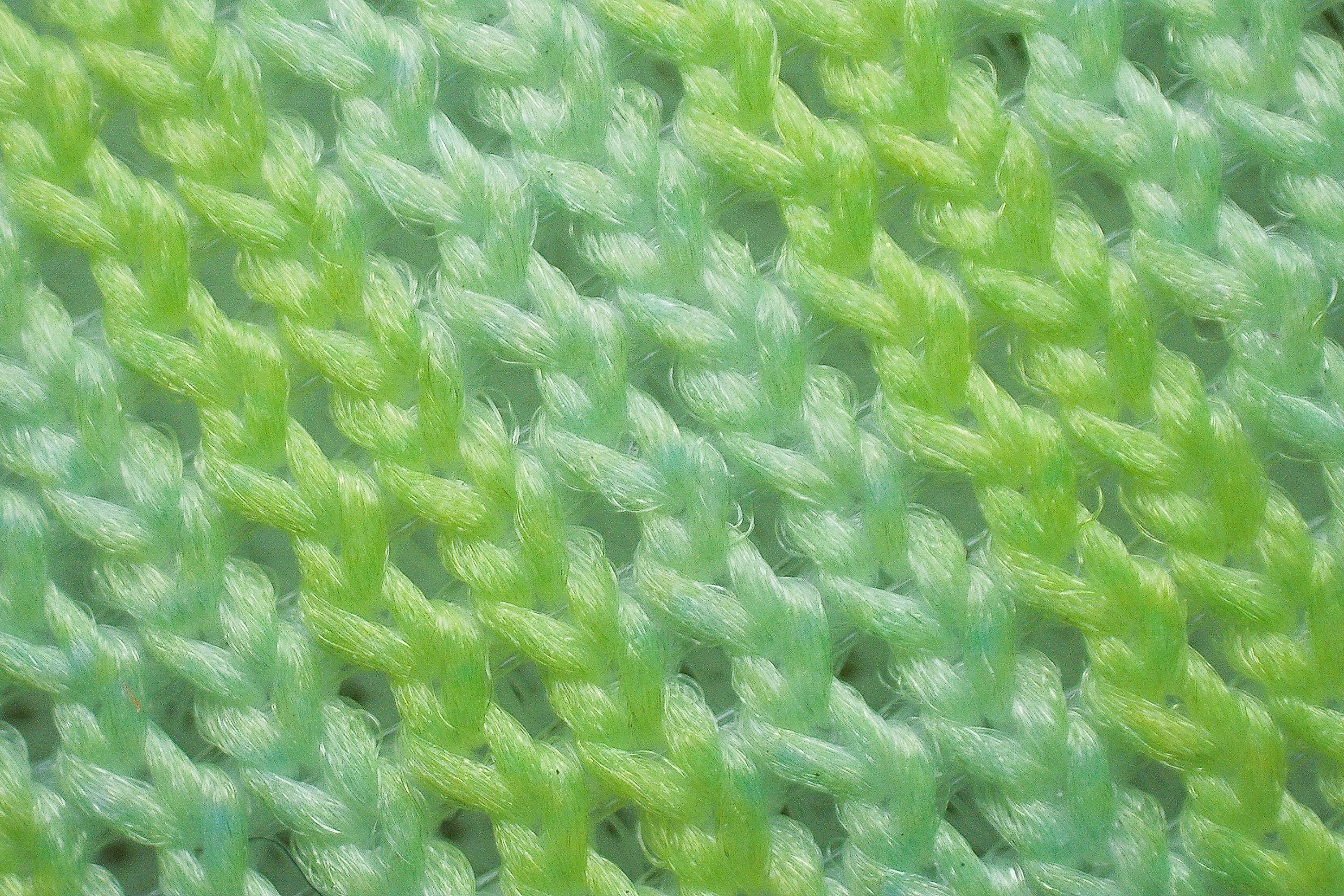
| Wave Rebellion | 3 |
| Average | 3.7 |
Stability
Lateral stability test
The Wave Rebellion proves itself as a trustworthy option for anyone seeking a fast-yet-stable and lightweight running shoe.
Torsional rigidity
Mizuno's first step to achieve stability is to integrate a fibreglass plate into the midsole. This feature is actually why we awarded it a solid 4/5 on our torsional rigidity test.
| Wave Rebellion | 4 |
| Average | 3.5 |
Heel counter stiffness
Simultaneously, Mizuno opts for a stiff heel counter, ensuring stability for heel strikers and preventing heel slippage.
This might come at the expense of comfort, and we found it worthy of a strong 4/5 rating.
| Wave Rebellion | 4 |
| Average | 2.9 |
Midsole width - forefoot
The third element that enhances stability is the shape of the shoe.
With a forefoot width of 115.1 mm, this Mizuno model is undeniably wider than the average running shoe, outpacing most of its speed-training rivals.
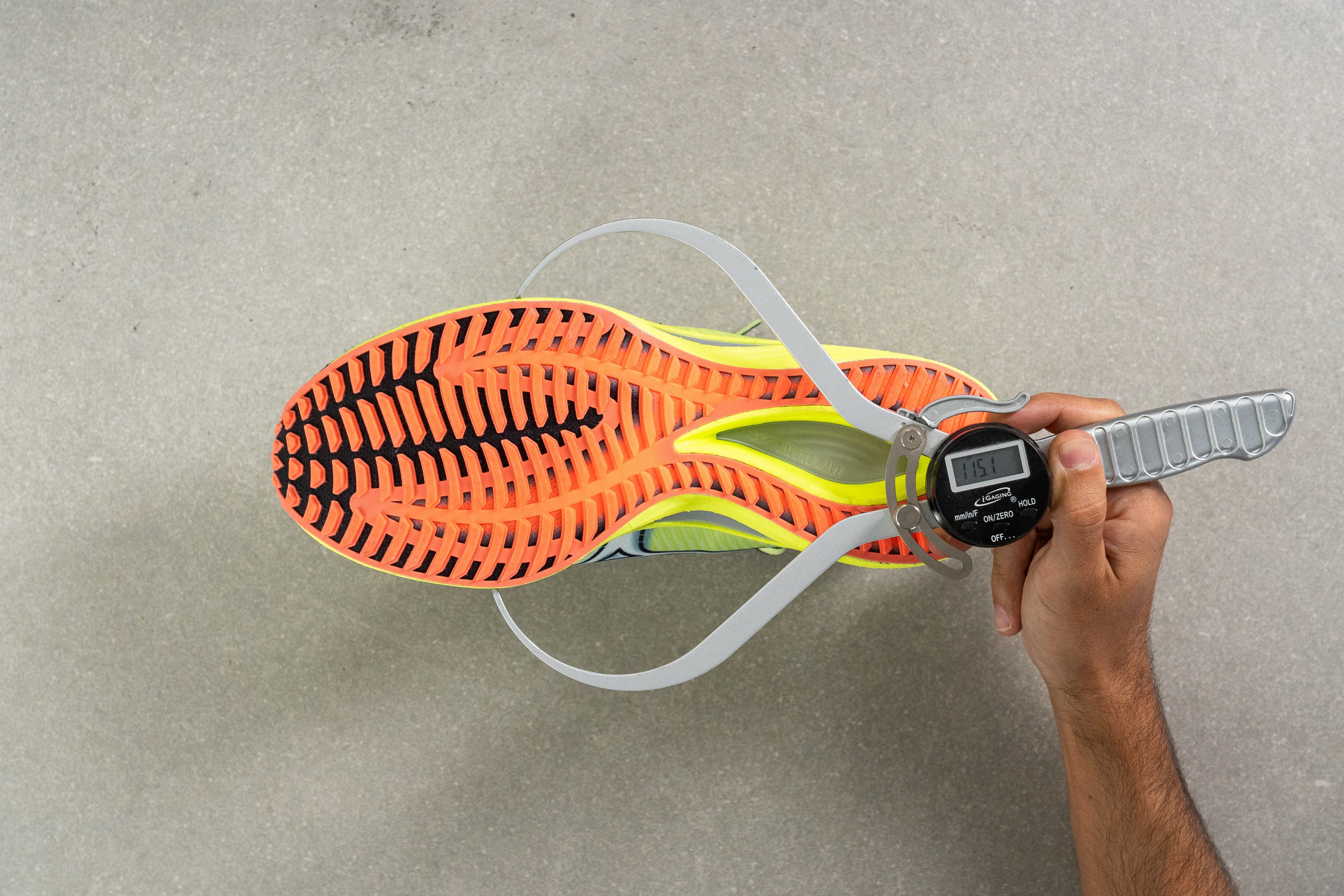
| Wave Rebellion | 115.1 mm |
| Average | 114.4 mm |
Midsole width - heel
However, the heel is slightly narrower (87 mm) compared to most other shoes on the market. But the difference is small, so we don't see it posing a problem for any runner.
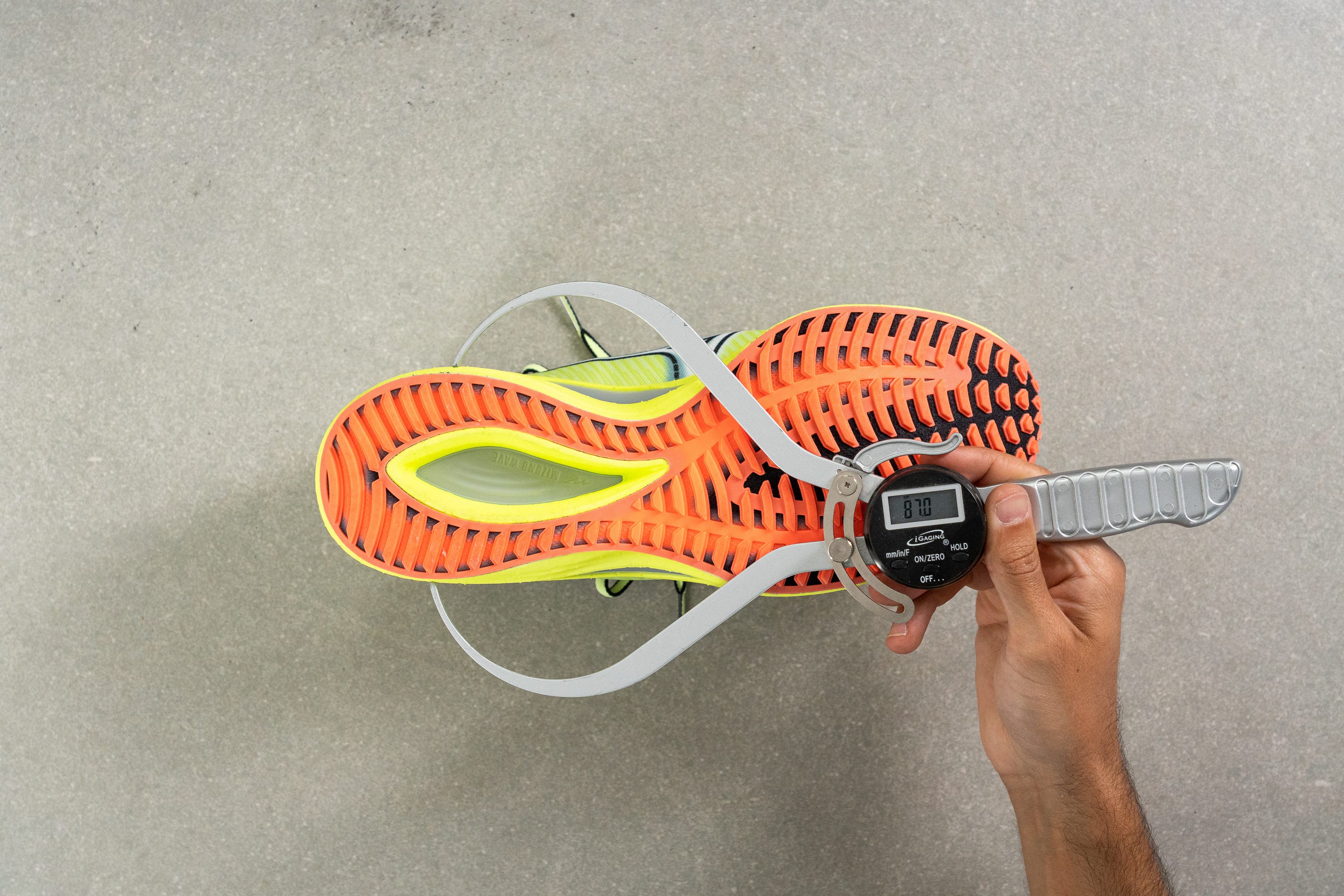
| Wave Rebellion | 87.0 mm |
| Average | 90.7 mm |
Durability
Toebox durability
Though we weren't blown away by the breathability, this is just the beginning, and there's room for improvement. We moved on to our durability test for the upper. Here, we use the Dremel in the same way on every shoe, allowing us to compare the damage accurately.
With the Wave Rebellion, the outcome wasn't as impressive as with the Nike Alphafly 2. However, it was sufficient to get a score of 2/5, which isn't a bad result by any means in this test.
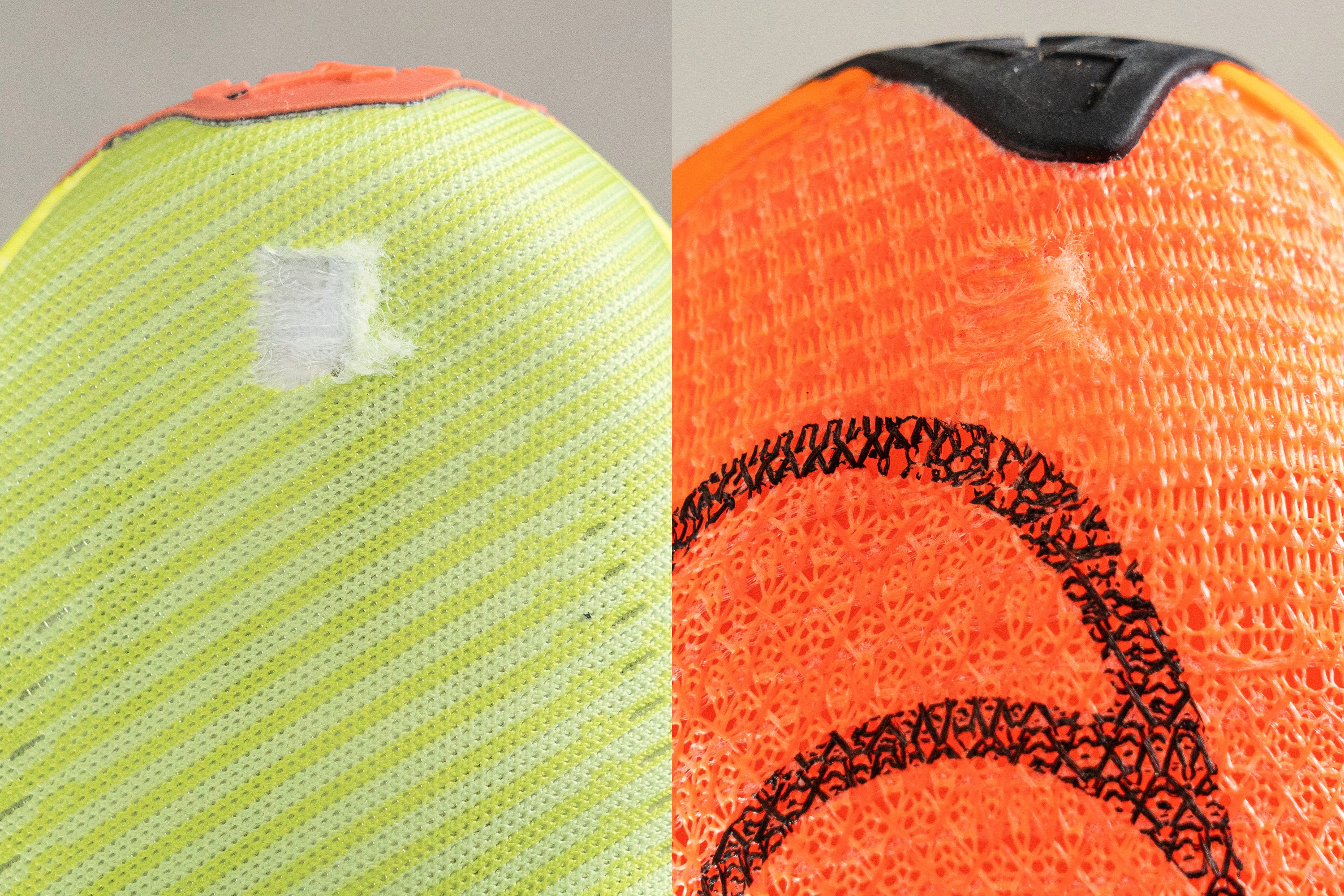
| Wave Rebellion | 2 |
| Average | 2.6 |
Heel padding durability
We conducted the same Dremel-based test on the heel.
This Mizuno running shoe mirrored its earlier performance in the toebox, earning a score of 2/5.
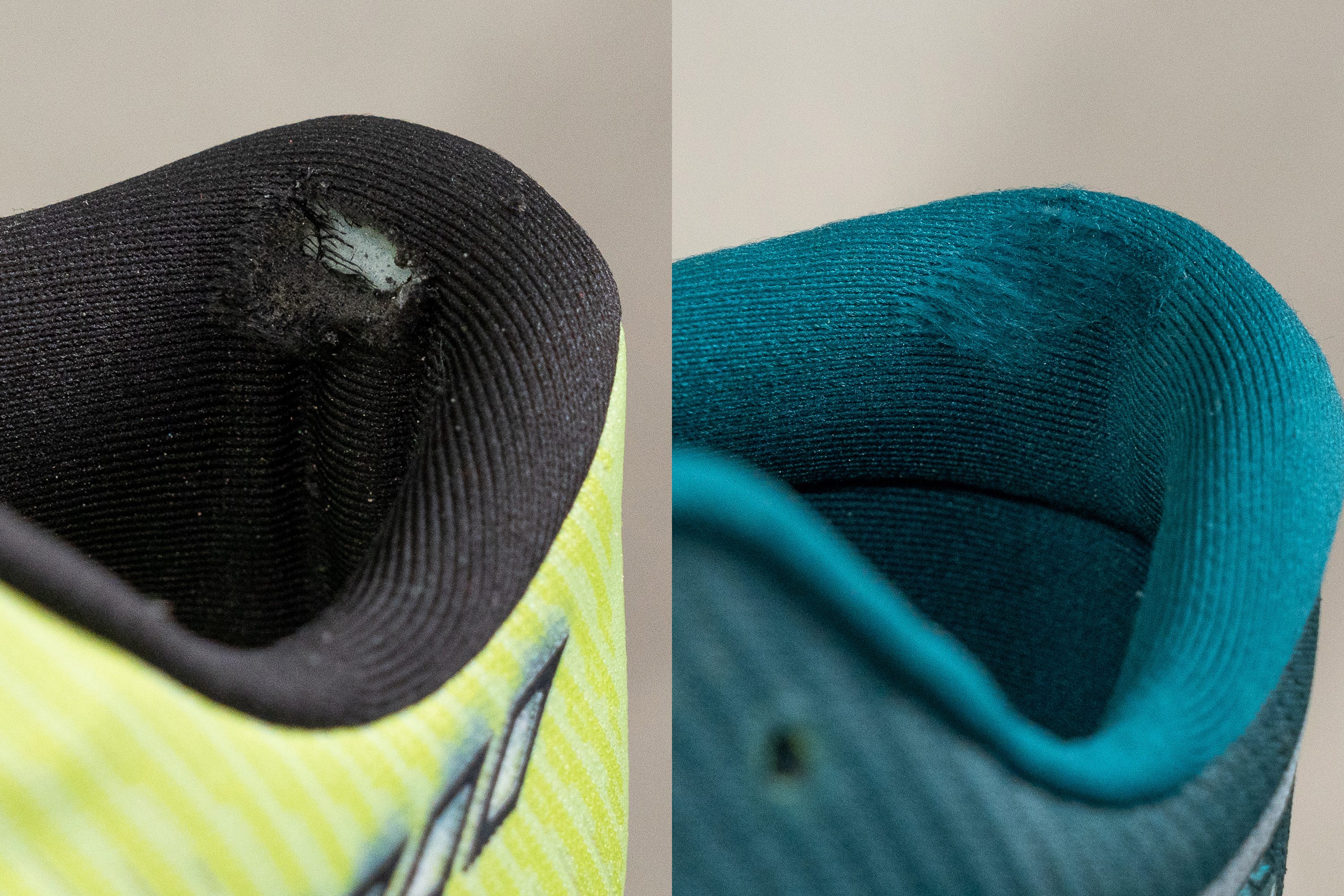
| Wave Rebellion | 2 |
| Average | 3.4 |
Outsole hardness
This outsole is one of the most fascinating we've encountered recently. Mizuno has deviated from the conventional outsole pattern, opting for a multi-lug arrangement that includes a large cutout in the heel's centre—where the fibreglass Wave Plate is visible.
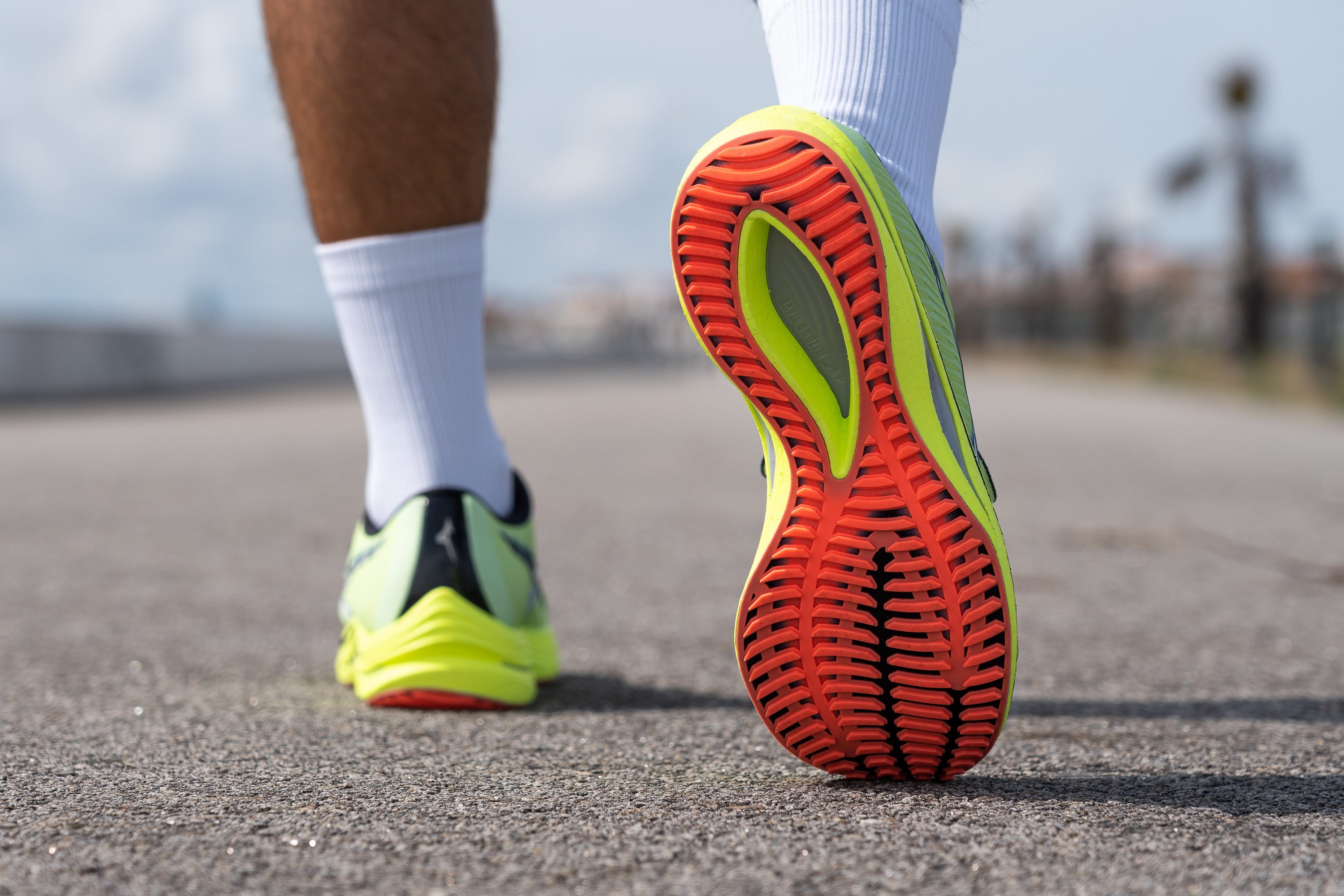
This particular design choice explains why Mizuno went with a 84.0 HC rubber, which is harder than average. They're attempting to counterbalance the lessened ground contact area due to the reduced rubber.
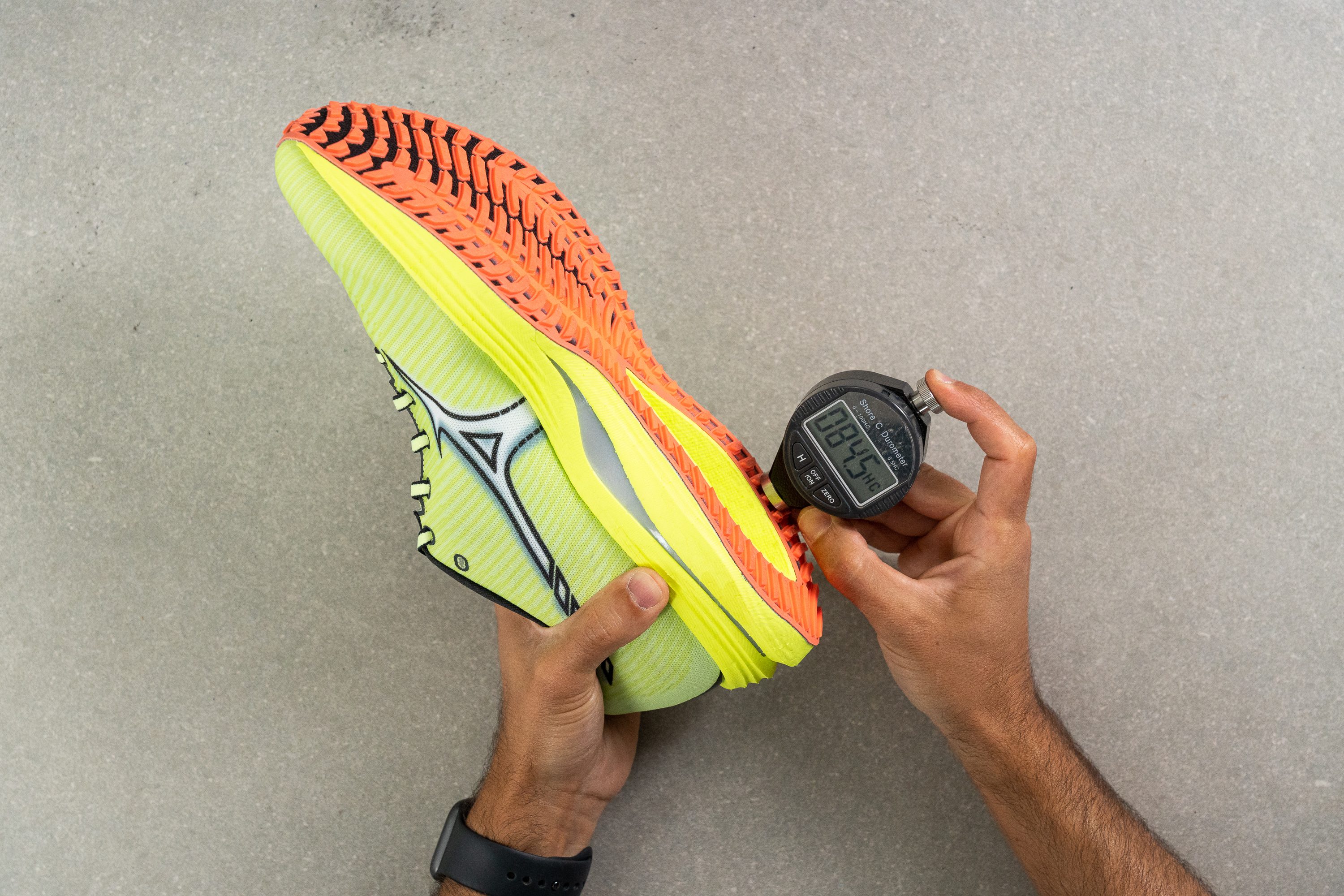
| Wave Rebellion | 84.0 HC |
| Average | 79.2 HC |
Outsole durability
Yet, we encountered an issue. As we used again the Dremel to gauge the outsole's durability, we were taken aback by the extent of the damage.
The lug was simply ruined. Regrettably, we have to report that Mizuno's strategy to enhance durability didn't worked at all. And you want a £180 shoe to last as much as possible.

| Wave Rebellion | 3.9 mm |
| Average | 1.1 mm |
Outsole thickness
It's important to remember that this isn't your average running shoe outsole—it's a multi-lug configuration that performs exceptionally well on both roads and dirt paths, and it's really nice for taking sharp turns.
We recorded the outsole thickness as 3.7 mm, which is probably too low given the poor durability shown before.

| Wave Rebellion | 3.7 mm |
| Average | 3.2 mm |
Misc
Insole thickness
At 4.1 mm, the insole checks out just as we anticipated—it won't cause any trouble and it's comfortable enough for long runs.
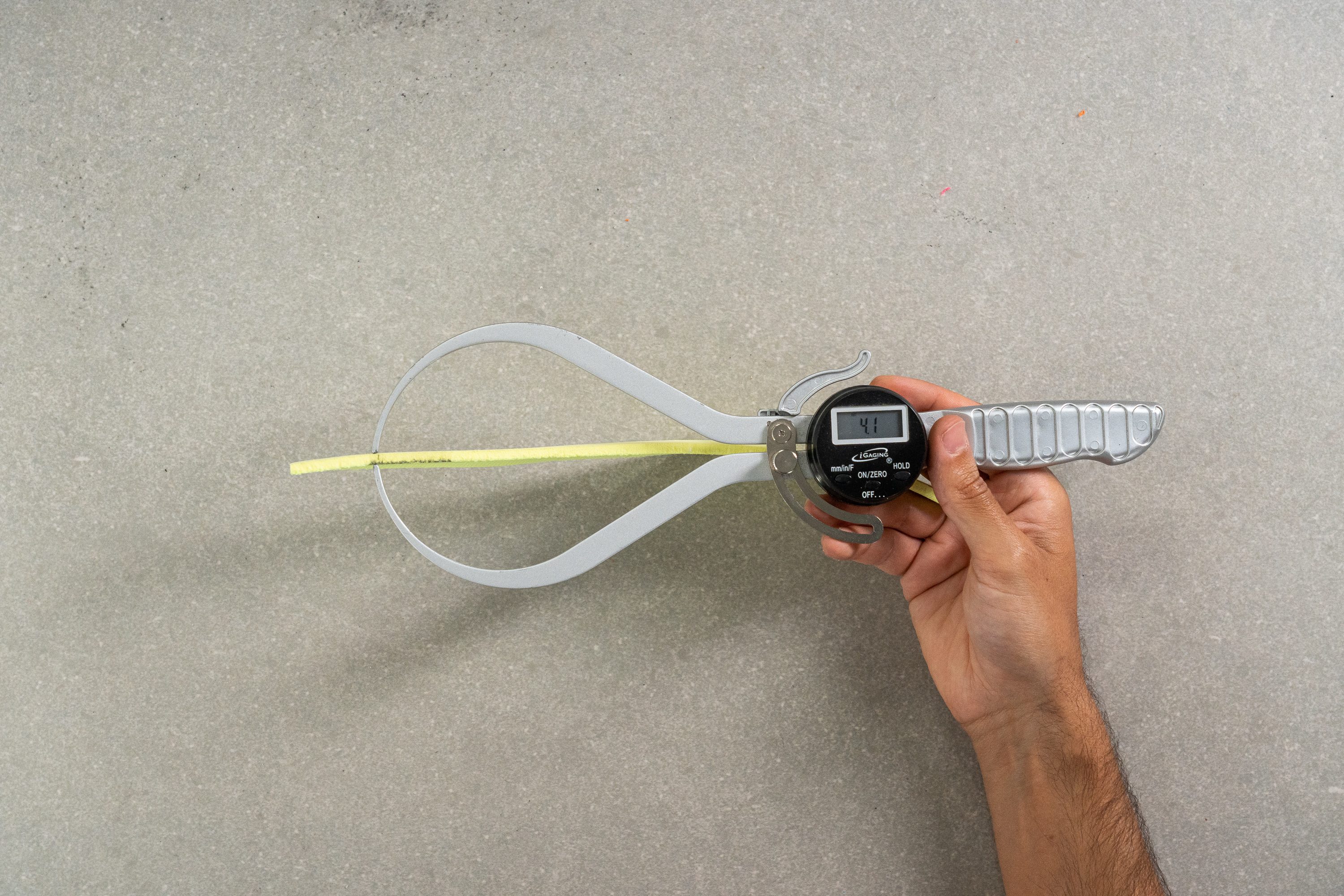
| Wave Rebellion | 4.1 mm |
| Average | 4.5 mm |
Removable insole
Removing the insole isn't a problem at all in this Mizuno tempo training shoe.
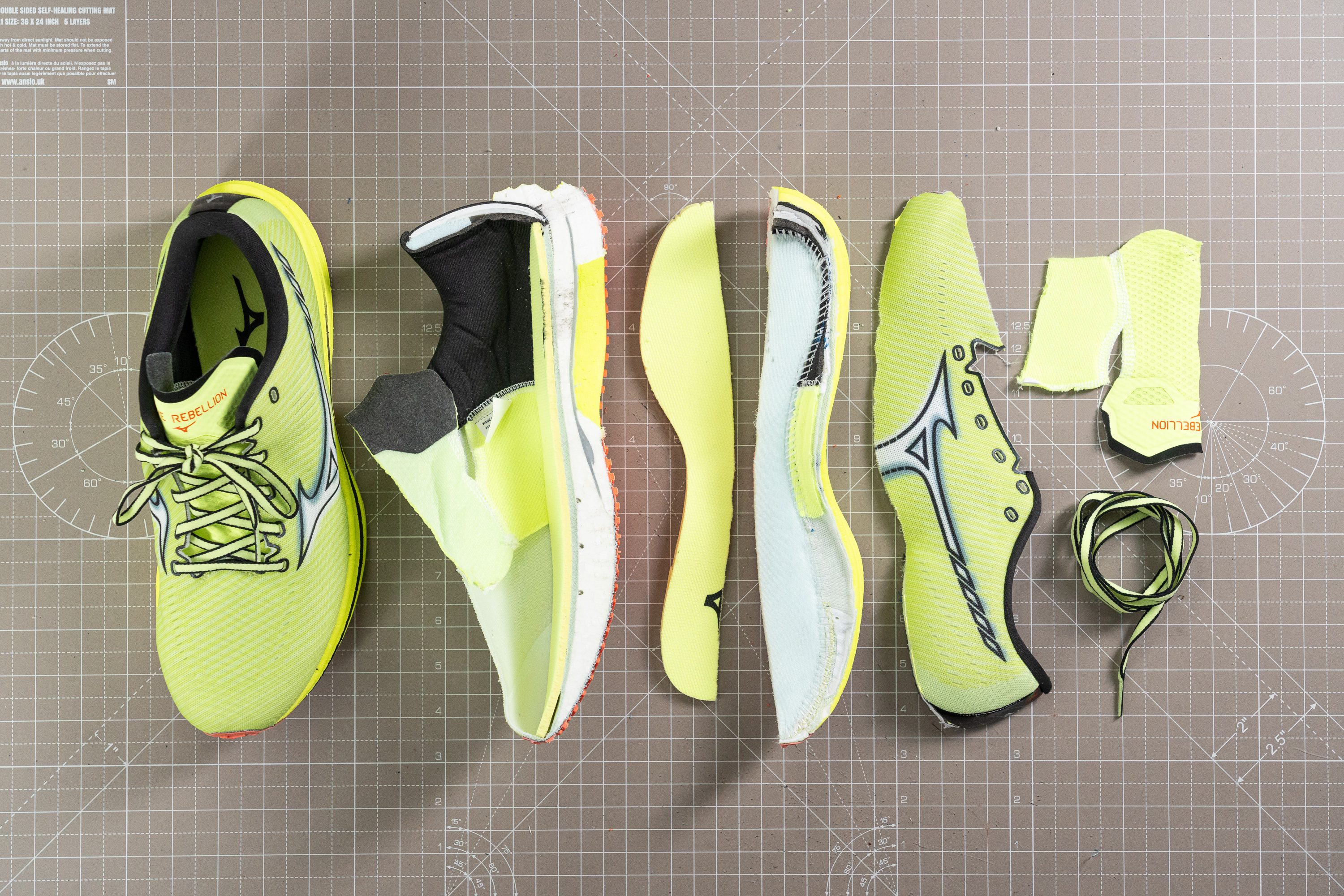
| Wave Rebellion | Yes |
Midsole softness in cold
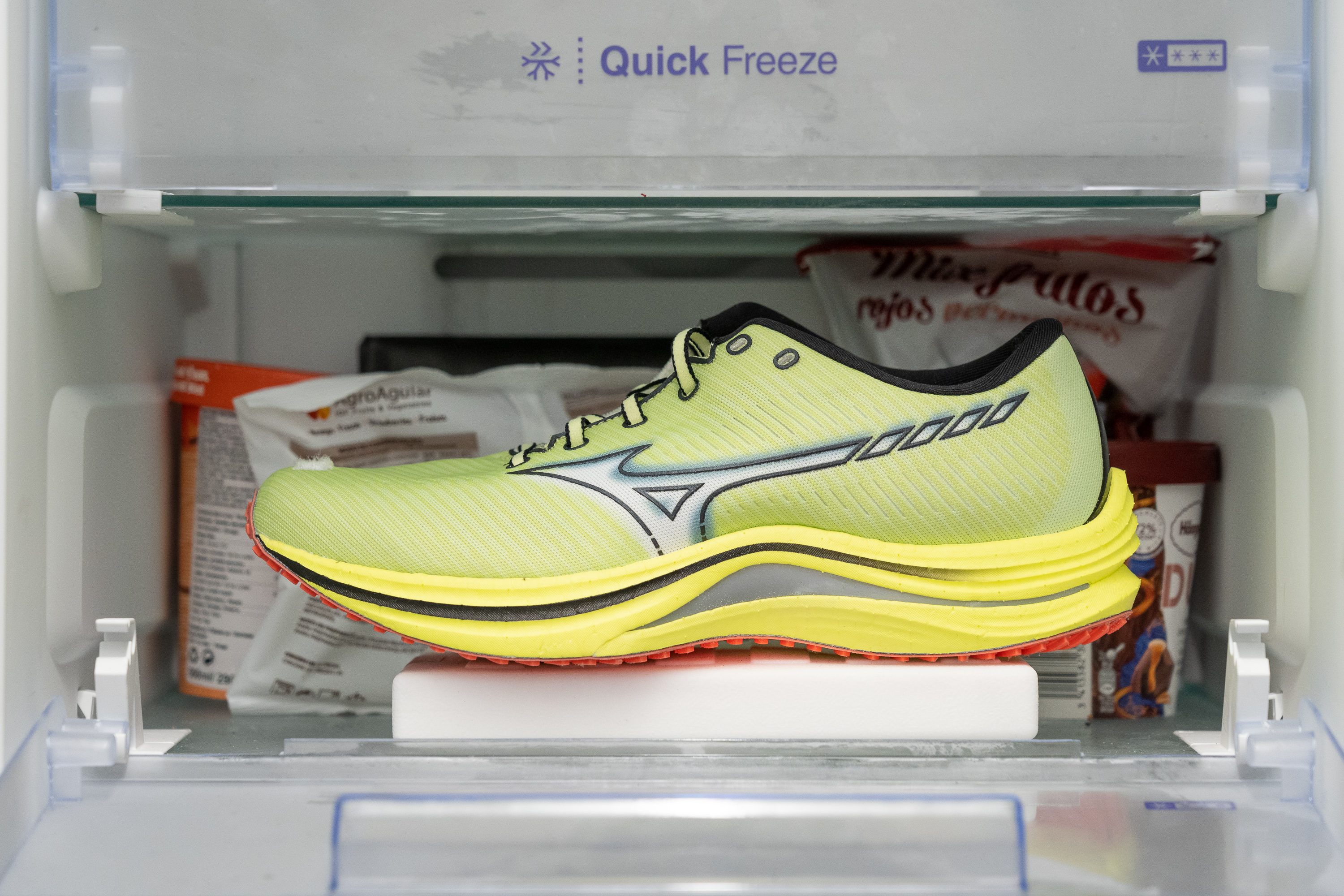
Midsole softness in cold (%)
Sadly, the shoe becomes noticeably firmer in colder temperatures. After leaving it in our freezer for 20 minutes, we took another measurement and saw a jump to 33.5 HA on the durometer reading.
This is a significant increase of 38.1%, which lags behind the performance of an average shoe.
We do wish Mizuno had chosen to use Enerzy Lite+ (PEBA) for this one, which would be appropiate given its MSRP.
| Wave Rebellion | 38% |
| Average | 24% |
Reflective elements
Sadly, we noticed that Mizuno has opted not to include any reflective elements on this shoe, which is quite disappointing.
Could this decision be again in pursuit of weight savings? It's likely!
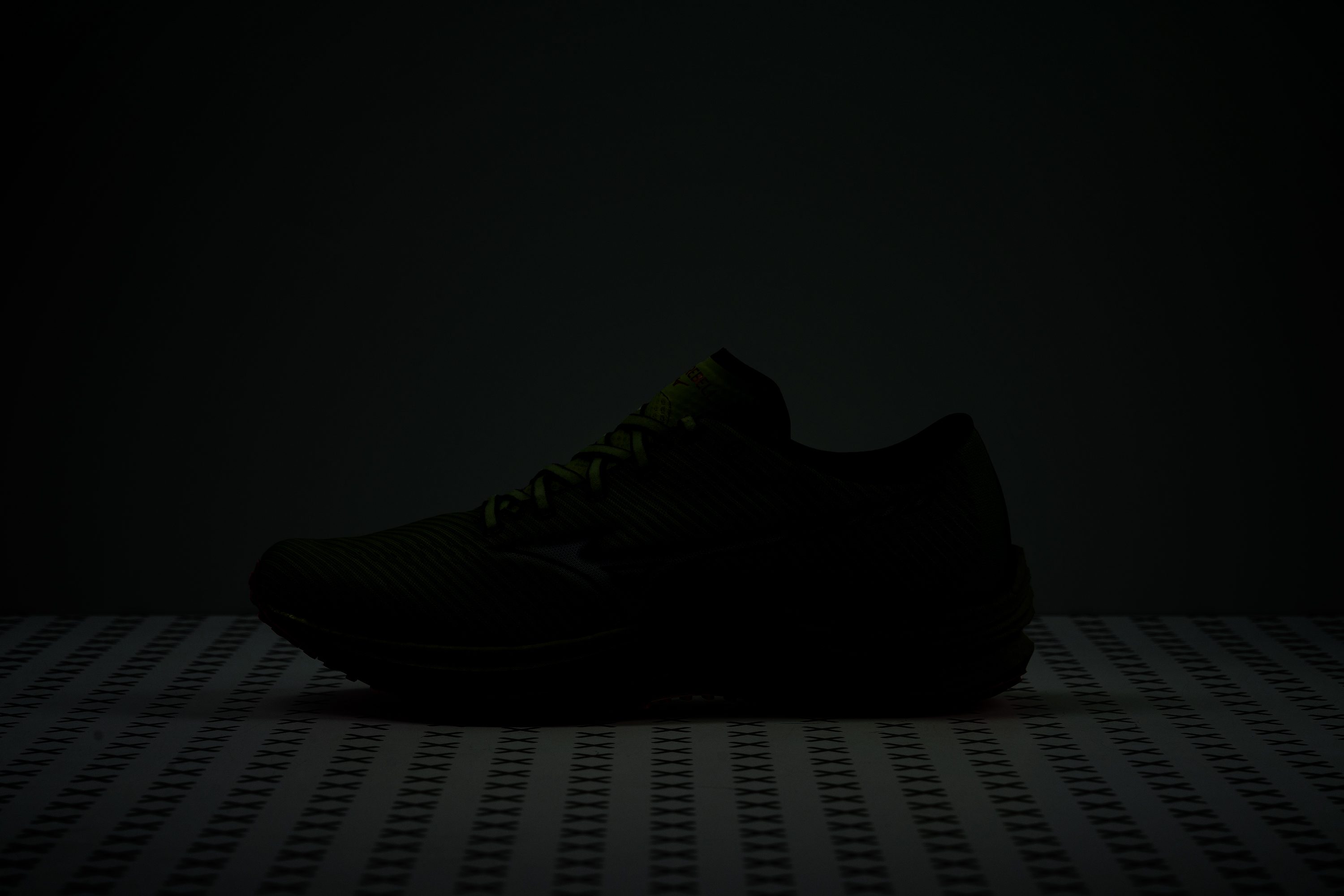
| Wave Rebellion | No |
Tongue padding
Mizuno has certainly prioritised weight savings when it comes to the tongue of the shoe. We found ourselves wishing for a bit more padding, though.
The Wave Rebellion comes with a mere 0.9 mm of padding in the tongue, which gives it a feel more akin to a racing shoe!
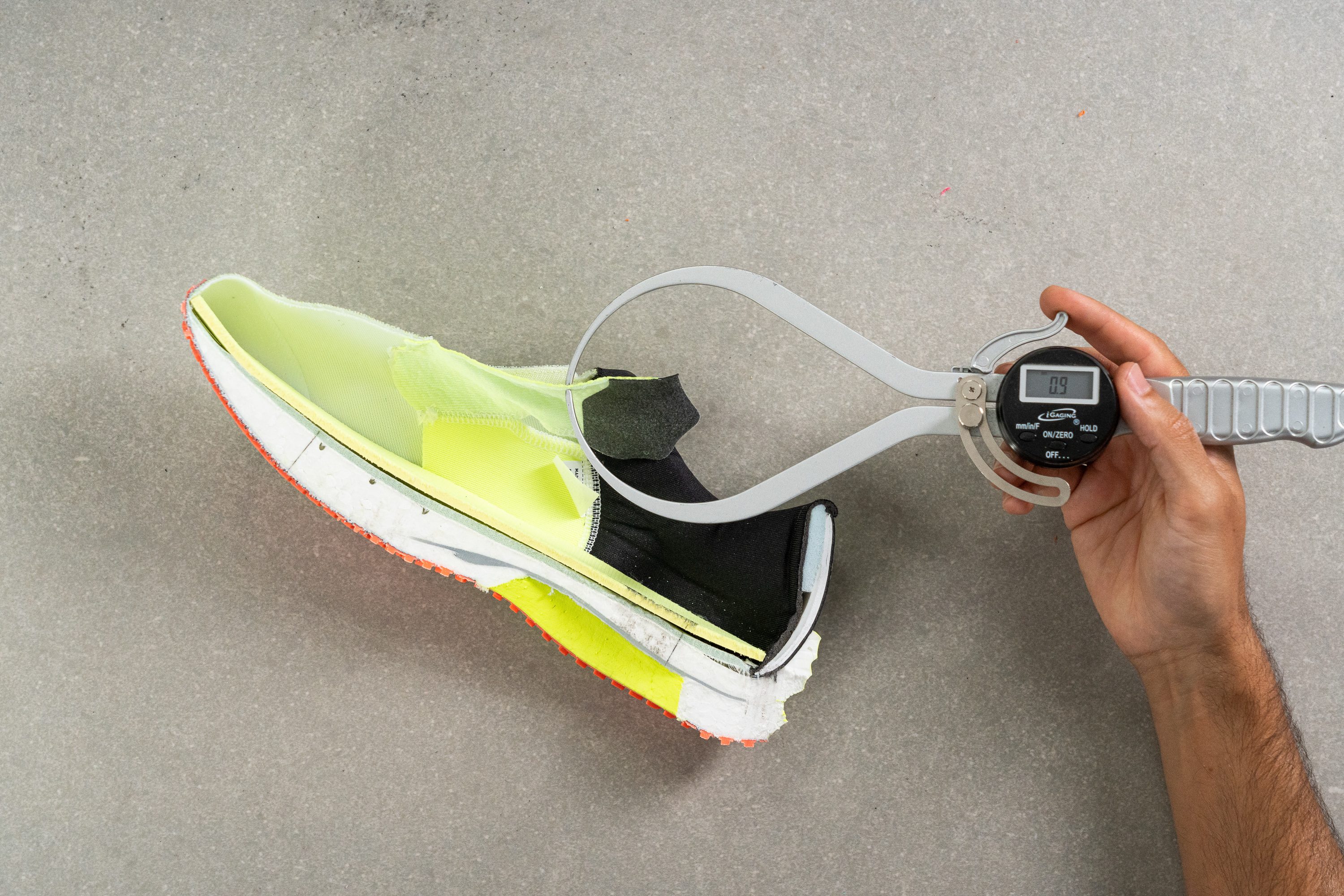
| Wave Rebellion | 0.9 mm |
| Average | 5.8 mm |
Tongue: gusset type
For a speed-focused trainer like this, a gusseted tongue is essential. Mizuno meets our expectations by incorporating a semi-gusseted one. It effectively keeps the tongue in place during our runs, offering a comfortable fit without any hint of constriction.
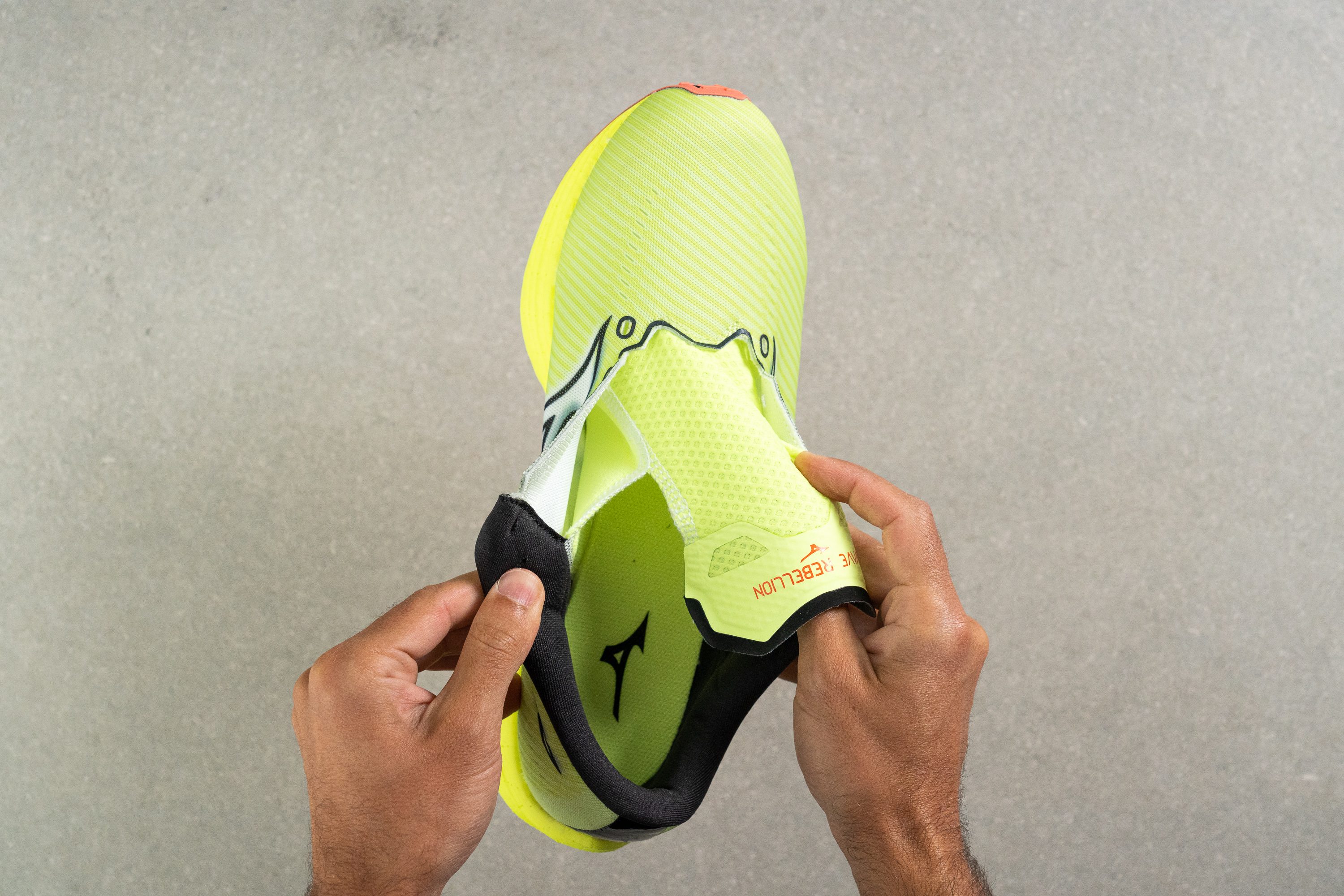
| Wave Rebellion | Both sides (semi) |

